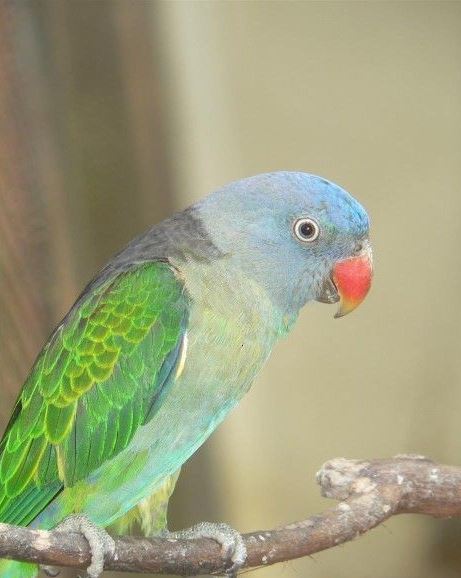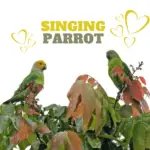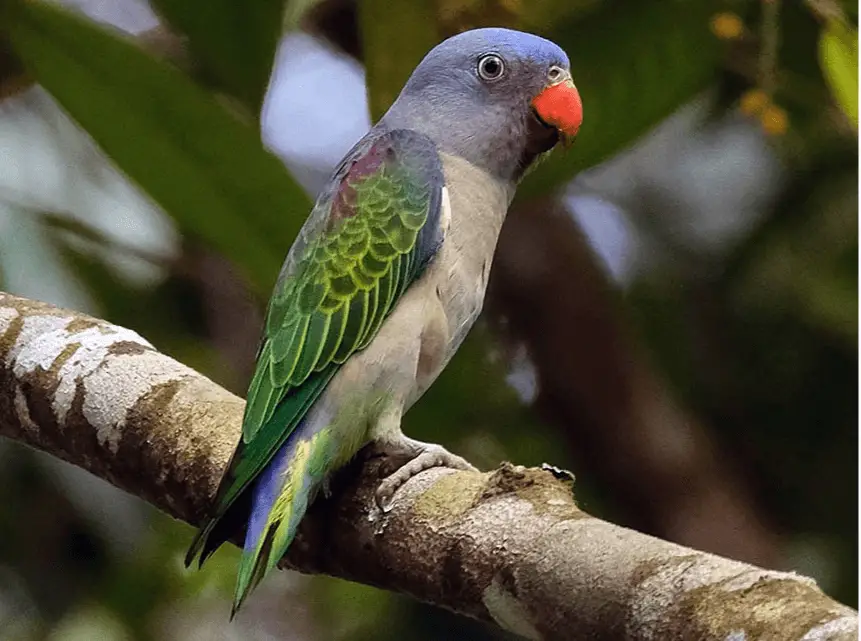Blue-rumped Parrot 18–19·5 cm. Upper mandible red (lower duller); head lavender-blue; underparts greyish olive with a yellow pectoral tuft, shading ventrally to yellowish green; mantle, upper back, and primary-coverts indigo-black; lower back to upper tail-coverts bright blue; rest of wing green edged yellow; flanks and underwing-coverts red; tail greenish-yellow;
iris yellowish-white or creamy-white, legs and feet blue-grey. The Female has a brownish bill, brown head with coppery crown, yellowish-green below, and a small blue dorsal patch.
Immature has grass-green head and body with yellow fringes to wing-coverts, males soon developing red upper mandible. Race Pontius is slightly larger.
Blue-rumped Parrot (Simeulue)
c. 19 cm. Fairly small, bright green, a stocky parrot with a very short tail. Blue face with green forecrown, and strong, narrow black headcollar.
The Female has an all-green head. No geographical overlap with smaller P. cyanurus (wing of male mean 144·2 mm, versus 111–126 mm in cyanurus),
which does not occur with P. abbotti but is present in Mentawi Is (previously treated as conspecific, see Taxonomy comments), has all-blue head, dark-grey mantle and back, powder-blue rump, and lacks black headcollar.
Systematics History

Editor’s Note: This article requires further editing work to merge existing content into the appropriate Subspecies sections. Please bear with us while this update takes place.
Blue-rumped Parrot (Blue-rumped)
Hitherto treated as conspecific with P. abbotti (which see). Two subspecies recognized.
Blue-rumped Parrot (Simeulue)
Hitherto treated as conspecific with P. cyanurus, but differs in its stronger green underparts (ns[1]); larger size (both sexes) (effect size vs P. c. pontius, which is itself larger than P. c. cyanurus, 2.62 for wing, 2.85 for tail, score 2); lack of grey mantle and back (3); lack of powder-blue rump (3); green vs brown hood in female (3); strong blue crown and hood with sharp blackish hindcollar (ns[1]). Monotypic.
Subspecies
Blue-rumped Parrot (Blue-rumped)Psittinus cyanurus cyanurus/Pontius
P. c. cyanurus+1
SUBSPECIES
Psittinus cyanurus cyanurus Scientific name definitions
Distribution
Psittinus cyanurus pontius Scientific name definitions
Distribution
Blue-rumped Parrot (Simeulue)Psittinus cyanurus abbotti Scientific name definitions
P. c. abbotti+1
Distribution
Distribution
Blue-rumped Parrot (Simeulue) Simeulue and Siumat, off NW Sumatra.
Habitat

Blue-rumped Parrot (Blue-rumped) Plains-level primary and logged rainforest, forest edge and clearings, oil-palm, rubber, and coconut plantations, exceptionally mangroves, generally up to 700 m (observed once at 1300 m in Peninsular Malaysia). Observed mainly in dry forest areas and kerangas, Kalimantan.
Blue-rumped Parrot (Simeulue) Presumably similar to P. cyanurus, i.e. in evergreen and semi-evergreen lowland forest, both mature and selectively logged, as well as edge vegetation, cultivated areas, forest clearings, and occasionally mangroves.
Migration Overview
Blue-rumped Parrot (Blue-rumped) Long-distance, possibly nomadic dispersal suspected: birds may have very large home ranges or else follow seed-flushes opportunistically; evidence of seasonal aggregations in Kalimantan, and apparently only an irregular summer visitor to S Myanmar.
Blue-rumped Parrot (Simeulue) None recorded.
Diet and Foraging

Poorly documented. Mesocarp of oil-palm fruits extracted individually from the bunch, fruits of Macaranga rhizinoides and seeds of Parkia speciosa; also fruits of Averrhoa carambola. Usually forages at canopy level. Observed in flocks of up to 20, more usually in groups smaller than ten individuals.
No data are specific to this population, but presumably similar to P. cyanurus.
Sounds and Vocal Behavior
Flight call is a shrill, sharp chittering, two- or three-noted “chi, chi, chi”, “whee-chi-chi” or “chew-ee”, also some musical whistling notes, usually given while perched.
Blue-rumped Parrot (Simeulue) No known differences from P. cyanurus, although poorly studied.
Breeding
Blue-rumped Parrot (Blue-rumped) Nest inspection recorded late Nov and Feb, with eggs in May; May–Sept in Borneo . Nest in a small natural hole 30 m or more in live forest tree, including Shorea. Clutch three white eggs, size 23·1–26·5 mm × 20·3–21·3 mm.
Blue-rumped Parrot (Simeulue) Nothing known.
Conservation Status
Blue-rumped Parrot (Blue-rumped) Not globally threatened. CITES II. Currently considered Near Threatened. Global population thought to be > 100,000 individuals but declining.
Restricted to lowland forest in Greater Sundas, but the ability to exploit oil palms suggests it is relatively secure. Common in primary habitat, becoming uncommon in disturbed forest and plantations; estimated to be increasing locally in parts of Borneo.
Known from a number of protected areas across its range, e.g. Similajau National Park, Sarawak, and Ulu Segama Forest Reserve, Sabah. Widespread in Kalimantan and Brunei, considered scarce by some and not uncommon by others; huge concentrations in Mar recorded in one area.
Now sparse in S Thailand doubtless owing to deforestation. Overall forest cover loss in 2000–2010 estimated at 23·7% for Sumatra, 12% for Borneo, and 8·2% for Peninsular Malaysia; on Sumatra, it has been estimated that c.36% of primary forest cover in 1990 was lost by 2010 (including degraded primary forest).
However, its use of forest fragments, logged forest, second growth, other modified habitats, and habitats at higher elevations implies that the species should not be in rapid decline.
As many as 3180 entered the trade in 1990, almost all out of Malaysia, with no indication of effects on overall population levels. Record from China in May 2005 presumably an escapee.
Blue-rumped Parrot (Simeulue) Not globally threatened. Currently considered Near Threatened. CITES II. Population estimated by BirdLife International at 2500–9999 mature individuals,
but numbers have been stated to be fewer than 5000 individuals, although transect surveys on Simeulue in 1995 produced an estimate of 35,000–47,000 birds, which in turn might have been a substantial over-estimate;
thought to be stable at present, as habitat loss appears limited to date. However, on Simeulue, ongoing mining for gravel could result in localized habitat loss, with further mining planned there, as are large-scale oil-palm plantations, which could result in extensive habitat destruction, although the island is currently heavily forested.





















